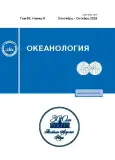Extreme Sea Level Variations in the Sea of Japan Caused by the Passage of Typhoons Maysak and Haishen in September 2020
- Autores: Smirnova D.A.1,2, Medvedev I.P.2
-
Afiliações:
- Lomonosov Moscow State University
- Shirshov Institute of Oceanology, Russian Academy of Sciences
- Edição: Volume 63, Nº 5 (2023)
- Páginas: 718-732
- Seção: Физика моря
- URL: https://journals.rcsi.science/0030-1574/article/view/140441
- DOI: https://doi.org/10.31857/S0030157423050179
- EDN: https://elibrary.ru/VCYZBI
- ID: 140441
Citar
Texto integral
Resumo
This study investigates extreme sea level variations recorded by tide gauges in the Sea of Japan during the passages of typhoons Maysak and Haishen in September 2020. Specific focus is on storm surges, seiches and infragravity waves identified in the records using tidal and statistical analyses. At most locations, storm surges, formed through the combined effect of atmospheric pressure changes and strong winds, were the major contributors to the extreme sea level events. For the Russian and Japanese coasts, the first typhoon, Maysak, turned out to have the greatest impact, while for the southeastern coast of the Korean Peninsula, the largest sea level variations were caused by the second typhoon, Haishen. At all sites, the passing storms induced eigen oscillations in the respective bays and harbours. Pronounced high-frequency oscillations with periods of two to seven minutes, which appear to be associated with infragravity waves, were recorded, reaching a maximum range of 2 m at Preobrazheniye. The observed differences in component content and associated characteristics of the observed sea level variations arise from differences in the topographic features of the corresponding coastal sites. Statistical analysis of the atmospheric pressure and wind speed series taken from weather stations and from the ERA5 reanalysis shows that atmospheric pressure is reproduced by reanalysis with high accuracy, whereas wind speed at different stations has significant discrepancies related to differences in orographic features.
Palavras-chave
Sobre autores
D. Smirnova
Lomonosov Moscow State University; Shirshov Institute of Oceanology, Russian Academy of Sciences
Autor responsável pela correspondência
Email: moscowdadas@gmail.com
Russia, Moscow; Russia, Moscow
I. Medvedev
Shirshov Institute of Oceanology, Russian Academy of Sciences
Email: moscowdadas@gmail.com
Russia, Moscow
Bibliografia
- Гидрометеорология и гидрохимия морей. Том 08. Японское море. Выпуск 1. Гидрометеорологические условия. Справочник. Проект Моря. Санкт-Петербург: Гидрометеоиздат, 2003. 397 с.
- Мамедов Э.С., Павлов Н.И. Тайфуны. Л.: Гидрометеоиздат, 1975. 144 с.
- Портал РП5: https://rp5.ru (Дата обращения: 15.04.2021).
- Портал NOAA Historical Hurricane Tracks: https:// coast.noaa.gov/hurricanes/#map=4/32/-80 (Дата обращения: 02.12.2020).
- Рабинович А.Б. Длинные гравитационные волны в океане: захват, резонанс, излучение. СПб: Гидрометеоиздат, 1993. 326 с.
- Российская служба предупреждения о цунами: http://www.rtws.ru/ (Дата обращения: 17.09.2020)
- Смирнов С.В. О сейшевых колебаниях в заливе Находка // Метеорология и гидрология. 2016. № 1. С. 78–85.
- Chupin V., Dolgikh G., Dolgikh S., Smirnov S. Study of free oscillations of bays in the northwestern part of Posyet Bay // Journal of Marine Science and Engineering. 2022. V. 10. № 8. P. 1005. https://doi.org/10.3390/jmse10081005
- Flanders Marine Institute (VLIZ); Intergovernmental Oceanographic Commission (IOC) (2022): Sea level station monitoring facility: http://www.ioc-sealevelmonitoring.org/map.php (Дата обращения: 17.09.2020). https://doi.org/10.14284/482
- Ha K.M. Predicting typhoon tracks around Korea // Natural Hazards. 2022. V. 106. P. 1639–1672. https://doi.org/10.1007/s11069-022-05335-6
- Heidarzadeh M., Rabinovich A.B. Combined hazard of typhoon-generated meteorological tsunamis and storm surges along the coast of Japan // Natural Hazards. 2021. V. 106. P. 1639–1672. https://doi.org/10.1007/s11069-020-04448-0
- Hersbach H., Bell B., Berrisford P. et al. The ERA5 global reanalysis // Quarterly Journal of the Royal Meteorological Society. 2020. V. 146. № 730. P. 1999–2049. https://doi.org/10.1002/qj.3803
- Hibiya T., Kajiura K. Origin of the Abiki phenomenon (a kind of seiche) in Nagasaki Bay // J. Oceanogr. Soc. Japan. 1982. V. 38. P. 172–182.
- Kim H.J., Kim D.B., Jeong O.J., Moon Y.S. The moving speed of typhoons of recent years (2018-2020) and changes in total precipitable water vapor around the Korean Peninsula // Journal of the Korean Earth Science Society. 2021. V. 42. № 3. P. 264–277. https://doi.org/10.5467/JKESS.2021.42.3.264
- Lin L.C., Wu C.H. Unexpected meteotsunamis prior to Typhoon Wipha and Typhoon Neoguri // Natural Hazards. 2021. V. 106. P. 1673–1686. https://doi.org/10.1007/s11069-020-04313-0
- MacMahan J. Low-frequency seiche in a large bay // J. Phys. Oceanogr. 2015. V. 45, P. 716–723. https://doi.org/10.1175/JPO-D-14-0169.1
- Medvedev I.P., Rabinovich A.B., Šepić J. Destructive coastal sea level oscillations generated by Typhoon Maysak in the Sea of Japan in September 2020 // Scientific Reports. 2022. V. 12. № 8463. https://doi.org/10.1038/s41598-022-12189-2
- Monserrat S., Vilibić I., Rabinovich A.B. Meteotsunamis: atmospherically induced destructive ocean waves in the tsunami frequency band // Natural Hazards and Earth System Sciences. 2006. V. 6. № 6. P. 1035–1051. https://doi.org/10.5194/nhess-6-1035-2006
- Munk W.H. Surf beats // EOS, Transactions American Geophysical Union. 1949. V. 30. № 6. P. 849–854. https://doi.org/10.1029/TR030i006p00849
- Rabinovich A.B. Seiches and harbor oscillations. In: Handbook of Coastal and Ocean Engineering / Ed. Kim. Y.C. Chapter 9. World Scientific Publ., Singapore, 2009. P. 193–236.
- Smirnov S.V. Yaroshchuk I.O., Shvyrev A.N. et al. Resonant oscillations in the western part of the Peter the Great Gulf in the Sea of Japan // Natural Hazards. 2021. V. 106. № 2. P. 1729–1745. https://doi.org/10.1007/s11069-021-04561-8
- Yuk J.H., Kang J.S., Myung H. Applicability study of a global numerical weather prediction model MPAS to storm surges and waves in the south coast of Korea // Atmosphere. 2022. V. 13. № 4. P. 591. https://doi.org/10.3390/atmos13040591
- Zhu D., Zhi X., Wang N. et al. Impacts of Changbai Mountain topography on the extreme precipitation from super typhoon Maysak // Front. Environ. Sci. V. 9. № 818402. https://doi.org/10.3389/fenvs.2021.818402
Arquivos suplementares















